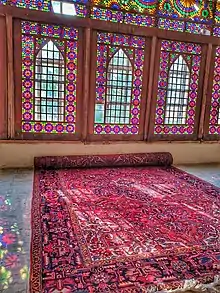Ahar rug
The Ahar rug, also called Ahar carpet, is a type of Persian carpet made in the town of Ahar in Ahar County near Mount Sabalan in Iran.[1]

The name of the rug references the city and region of origin.[2]
History
Over the last 30 years Ahar rugs have emerged as a recognizable group in the marketplace, and they are sold in many parts of Iran outside their town of origin.
Production
Ahar carpets are woven by people who live in Ahar county and by nomads in the region.[3] They are made in villages including Qunigh, Cheshme Vazan, Qurchi Kandi, Mazraeh-ye Hajj Abedin, Mazraeh-ye Mazare, Kaqalaq and Kalhur.[4]
Characteristics
The design incorporates a large medallion,[5] and it is geometric with curvilinear elements.[6] Thus, it is characterized as a rectilinear medallion-spandrel design.[4]
An Ahar rug may be recognized by its blue wefts, especially in the medallions.[7][6] The background is generally some shade of red, brick, or rose, and the large corners, created by the spandrels, are typically ivory-colored.[5][6]
A standard Ahar rug measures approximately 9 x 12 feet.[6] The rug is designed so the knot counts are higher but no higher than many carpets that have the geometric design. The rug has a cotton or wool[5] base with a knot density of 65 symmetrical knots per square inch.[7] The rugs are known for their quality compared to other Persian handmade rugs.[6]
It is a distinctive carpet in the Heriz group of carpets.[8][9] It is influenced by the Heriz and Tabriz styles.[6]
References
- Nouri-Zadeh, Sh., Persian Carpet; The Beautiful Picture of Art in History, Retrieved on June 5, 2008
- Clare, Andrew (2017-04-25). "Constructing an Index of Persian Rug Prices". Rochester, NY. doi:10.2139/ssrn.2958111. Cite journal requires
|journal=(help) - Sarvar H., Kashani Asl A., Salahi Sarikhan Biglou V., Lalepour M. 2015. Evaluation of the Capabilities of Development of Ahar city of Iran, with an Emphasis on the Role of Road Transportation Network. J. Civil Eng. Urban., 5(2):108-115.
- Abdi, Somayeh; Bassam, Seyed Jalal Eddin; Mirzaei, Abdollah (2015-09-10). "Analysis of Design and Pattern of Contemporary Village Carpets of Ahar". Journal Scientific Goljaam. 11 (27): 77–97.
- "Ahar rug origin and description guide". www.little-persia.com. Retrieved 2021-01-01.
- Jacobsen, Charles (2012-08-21). Oriental Rugs a Complete Guide. Tuttle Publishing. ISBN 978-1-4629-0415-0.
- Stone, Peter F. (2013-11-19). Oriental Rugs: An Illustrated Lexicon of Motifs, Materials, and Origins. Tuttle Publishing. ISBN 978-1-4629-1184-4.
- "Ahar rugs". JOZAN. Retrieved 2021-01-01.
- Maitra, K. K. (2007-11-15). Encyclopaedic Dictionary of Clothing and Textiles. Mittal Publications. ISBN 978-81-8324-205-9.